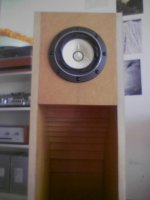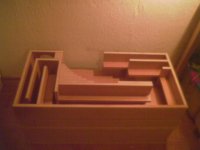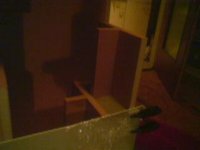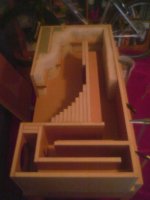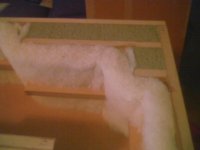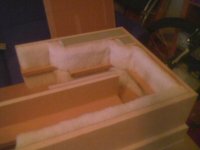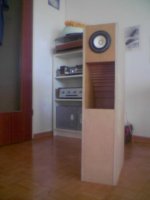Hi there,
Well, after a considerable break I have finally finished my speakers. They sound...brilliant.
They are currently fed by my (Sony) stereo, which is not so high-end, and an old tube-amp (a bit hum but warm sound). Hopefully my Zen-light is finished soon.
The pics are a bit blur.
Well, after a considerable break I have finally finished my speakers. They sound...brilliant.
They are currently fed by my (Sony) stereo, which is not so high-end, and an old tube-amp (a bit hum but warm sound). Hopefully my Zen-light is finished soon.
The pics are a bit blur.
Attachments
I just got a Fostex BK10 kit from Japan which is supposed to be okay for use with the Fostex FE126E (which I've already ordered but haven't received); however, it looks like using this driver will only give me .47" (12 mm) between the back of the driver, and the wall of the compression chamber, which won't leave me much space for any acoustic material on the compression chamber wall.
(The instructions are in Japanese, but they seem to indicate that felt should be used to line back of the compression chamber.)
There are shallower drivers like the FE103E which will leave me over an inch of space. How important is this distance? Should I get a driver that's not as deep? The kit instructions also mention the FE108EZ, the FE107E, the FF125K, and the FE127 as suitable drivers.
Thanks!
(The instructions are in Japanese, but they seem to indicate that felt should be used to line back of the compression chamber.)
There are shallower drivers like the FE103E which will leave me over an inch of space. How important is this distance? Should I get a driver that's not as deep? The kit instructions also mention the FE108EZ, the FE107E, the FF125K, and the FE127 as suitable drivers.
Thanks!
Hi All,
Since I have a strange international life and work, my contributions to these conversations are spotty. I apologise for this. BUT I was visiting family over Thanksgiving holiday and was able in that time to complete an original design for a rear firing BLH using fostex FE103E drivers. Following Martin King's advise to keep true to the internal geometry of the fostex designed cabinet, I did one better and tried to keep a continuous expansion of the horn, rather than a stepped expantion, as fostex uses. These are my first horn type speaker (I did a folded TQWT before), so I felt I was taking a small risk going with a shot in the dark design.
To make this short, I made the cabinets with just with enough time to put them together and listen to them for a night before I had to fly back to Asia. There was no dampening in these things and they sounded great!! Warm where they had to be and crisp elsewhere. I did not hear any strangeness that made me think they would need dampening, but they may change some after break in.
When I am back at my home base (out in the field now) I will post some of the pics I have.
Regards fellow single driver horn freaks. I am sold!!
Stuart
Since I have a strange international life and work, my contributions to these conversations are spotty. I apologise for this. BUT I was visiting family over Thanksgiving holiday and was able in that time to complete an original design for a rear firing BLH using fostex FE103E drivers. Following Martin King's advise to keep true to the internal geometry of the fostex designed cabinet, I did one better and tried to keep a continuous expansion of the horn, rather than a stepped expantion, as fostex uses. These are my first horn type speaker (I did a folded TQWT before), so I felt I was taking a small risk going with a shot in the dark design.
To make this short, I made the cabinets with just with enough time to put them together and listen to them for a night before I had to fly back to Asia. There was no dampening in these things and they sounded great!! Warm where they had to be and crisp elsewhere. I did not hear any strangeness that made me think they would need dampening, but they may change some after break in.
When I am back at my home base (out in the field now) I will post some of the pics I have.
Regards fellow single driver horn freaks. I am sold!!
Stuart
It's quite a heavy beast.
The break-in was fascinating, one could hear the bass developing during play.
My first impression: Definitely not bad for one single driver. Can't wait to hear different amps (+ some fat cable, nothing too fancy though).
And it reminds me that there's a plasma-tweeter project still waiting to be finished...
Oh, and yes, I'm unable (too stupid?) to add multiple pics to one single post.
Build nice or build twice.
The break-in was fascinating, one could hear the bass developing during play.
My first impression: Definitely not bad for one single driver. Can't wait to hear different amps (+ some fat cable, nothing too fancy though).
And it reminds me that there's a plasma-tweeter project still waiting to be finished...
Oh, and yes, I'm unable (too stupid?) to add multiple pics to one single post.
Build nice or build twice.
Attachments
Rodeodave said:(+ some fat cable, nothing too fancy though).
Make sure you try some solid skinny stuff too...
Oh, and yes, I'm unable (too stupid?) to add multiple pics to one single post.
Only 1 pic/post if you upload them to the database.
dave
dave,
Solid skinny stuff? Like magnet wire (solid core), used for winding transformers or inductors, or what?
Another question:
Could you please tell me something (basics) about phase plugs? What difference would one make on an FE108EZ, considering the shape of the dustcap?
Solid skinny stuff? Like magnet wire (solid core), used for winding transformers or inductors, or what?
Another question:
Could you please tell me something (basics) about phase plugs? What difference would one make on an FE108EZ, considering the shape of the dustcap?
Rodeodave said:Solid skinny stuff? Like magnet wire (solid core), used for winding transformers or inductors, or what?
That works... just due to convieneince, i've been using cyro-treated Cat 5 strands lately...
Could you please tell me something (basics) about phase plugs? What difference would one make on an FE108EZ, considering the shape of the dustcap?
I've not tried it on an FE108EZ (but i have my own pair now).... both installations i know of report back positively (one was a dust cap push in recovery)
<http://www.planet10-hifi.com/pp-info.html> a couple clicks down is a sidebar in a grey box that covers the major points.
dave
I've been thinking about adding a (small?) sub to the horns. In the link below I read that the XO should be around 200Hz. Any comments?
http://www.diyaudio.com/forums/full-range/67619-fe108ez-midrange.html
As fas as I understand it's very hard to do a passive crossover with these drivers. That's ok, even if I'm wrong, because I like the idea of bi-amping very much. Here is the active XO I intend to use.
It's the Xenover v2.0 by our very own Grey Rollins over at enjoythemusic.com
Xenover Ver. 2.0 Article By Grey Rollins
(btw, why is this not getting any attention?)
The FE108EZ will continue to be fed by a charming MiniA and for the subs I might even try one of them GainClones (bad idea?).
So my questions are:
Where should I start with the XO? 200Hz or higher?
Can anyone recommend a sub (driver/enclosure) that goes nicely with the Fostexes? Size (and cash) is sort of an issue but a TL is not completely out of question. The room they'll be in is close to 30m² and the speakers would be rather close to the wall (otherwise the door won't open).
http://www.diyaudio.com/forums/full-range/67619-fe108ez-midrange.html
As fas as I understand it's very hard to do a passive crossover with these drivers. That's ok, even if I'm wrong, because I like the idea of bi-amping very much. Here is the active XO I intend to use.
It's the Xenover v2.0 by our very own Grey Rollins over at enjoythemusic.com
Xenover Ver. 2.0 Article By Grey Rollins
(btw, why is this not getting any attention?)
The FE108EZ will continue to be fed by a charming MiniA and for the subs I might even try one of them GainClones (bad idea?).
So my questions are:
Where should I start with the XO? 200Hz or higher?
Can anyone recommend a sub (driver/enclosure) that goes nicely with the Fostexes? Size (and cash) is sort of an issue but a TL is not completely out of question. The room they'll be in is close to 30m² and the speakers would be rather close to the wall (otherwise the door won't open).
I'm not familiar with your particular speakers, but it would seem to me that you would want to cross over below 150Hz to avoid localization to the sub-woofer(s).
It's obviously more complex than that, probably some trade off between LF response flatness, maximum achievable spls, etc.. will come into play as well. If the current system has good usable response below 150Hz I would not cross-over higher than that.
It's obviously more complex than that, probably some trade off between LF response flatness, maximum achievable spls, etc.. will come into play as well. If the current system has good usable response below 150Hz I would not cross-over higher than that.
If you are going to cross over that high you need a pair of woofer (ie good midbasses) and not subwoofers proper. Even XOing at 80 Hz or so a midbass is much more likely to integrate than a subwoofer proper.
You will end up with more bass, but it is the midrange that will make the greatest gains.
There is a recent thread on buffered PLLXOs, this variation seems overly complex.
dave
You will end up with more bass, but it is the midrange that will make the greatest gains.
(btw, why is this not getting any attention?)
There is a recent thread on buffered PLLXOs, this variation seems overly complex.
dave
- Status
- This old topic is closed. If you want to reopen this topic, contact a moderator using the "Report Post" button.
- Home
- Loudspeakers
- Full Range
- Back Loaded Horn with FOSTEX, some questions...
